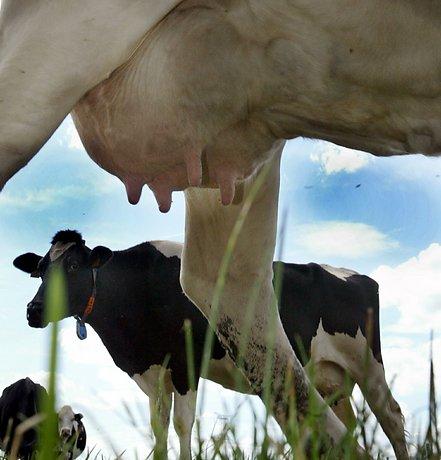Important mutation discovered in dairy cattle
Scientists have discovered a mutation with a built-in dilemma for dairy cattle breeders. The deleted gene sequence has a positive effect on milk yield but causes embryonic death in dairy cattle.

Scientists have found a genomic deletion that affects fertility and milk yield in dairy cattle at the same time. The discovery can help explain a dilemma in dairy cattle breeding: the negative correlation between fertility and milk production.
For the past many years milk yield in Scandinavian dairy cattle has gone in one clear direction: up. This has been due to targeted breeding programmes and modern breeding methods. Despite putting large weight in the breeding goal in Nordic countries, almost no improvement is achieved for fertility. It now seems that this unfavourable correlation between milk yield and fertility is partially affected by a deletion of a simple gene sequence. The presence and effects of this mutation have recently been discovered by scientists from Aarhus University, University of Liège, MTT Agrifood Research Finland, in collaboration with the Danish Agricultural Advisory Service and the Nordic Cattle Genetic Evaluation.
Scientists, farmers and advisors have generally assumed that the reduction in fertility is primarily due to the negative energy balance of high-producing cows at the peak of their lactation but now the scientists have also found a genetic explanation.
- We have discovered a deletion encompassing four genes as the causative variant and shown that the deletion is a recessive embryonically lethal mutation, explains Goutam Sahana. This means that the calves die while they are still embryos and are aborted or reported as insemination failure. The fact that the mutation is recessive means that both parents must carry it and pass the genes on to their calf for the calf to be affected. The bulls carrying the deletion can be routinely identified in on-going genomic selection program and by avoiding carrier-by-carrier matings a quantum jump in fertility could be achieved in Nordic red breeds, adds Goutam Sahana.
Can’t have your cake and eat it too
To make matters worse, this particular mutation has become rather common in Nordic Red cattle, however, the deletion is totally absent in Nordic Holstein and Danish Jersey populations. Based on the frequency of the mutation in the population, it is estimated that 2.89, 1.32 and 0.42% of embryos are dying in Finnish Ayshire, Swedish Red and Danish Red cattle respectively due to this mutation.
The reason that the deleted gene sequence causing embryo mortality has become relatively widespread is that it has such as strong positive effect on milk yield. By selecting for high milk yields, breeders have inadvertently also selected for embryo mortality – a situation of so-called hitchhiking.
- Our study demonstrates that embryonic lethal mutations account for a non-negligible fraction of the decline in fertility of domestic cattle and that associated positive effects on milk yield may account for part of the negative genetic correlation. This is at least the seventh example in livestock of an allele that is deleterious in the homozygous state being maintained at high frequency in the populations because of the selective advantage it confers to heterozygotes.
Read the scientific article in PLoS Genetics.
The study was funded by a grant from the Danish AgriFish Agency and was part of a larger project “Genomic selection- from function to efficient utilization in cattle breeding” and was part of the PhD project of Naveen Kumar Kadri carried out in collaboration between Aarhus University, University of Liège, MTT Agrifood Research Finland, Danish Agricultural Advisory Service and Nordic Cattle Genetic Evaluation.
For further information please contact:
Senior scientist Goutam Sahana
Center for Quantitative Genetics and Genomics (CGG)
Department of Molecular Biology and Genetics, Aarhus University, Denmark
e-mail: goutam.sahana@agrsci.dk, telephone: +45 8715 7501
